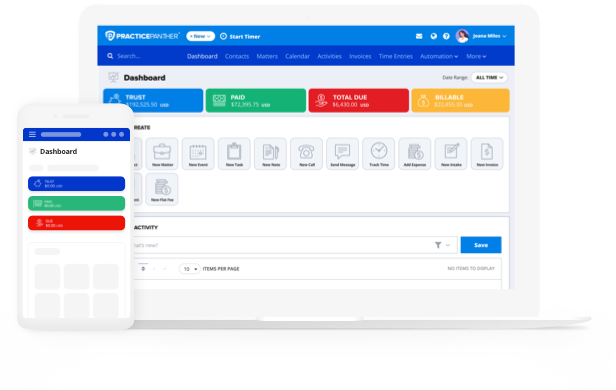Managing legal client intake can be a balancing act for many attorneys. Ask too much, and clients may abandon the form halfway through; ask too little, and you end up scrambling for details right when you’re deep into a case. Even seemingly minor oversights — like not getting a client’s preferred communication method or not capturing all opposing parties involved — can lead to delays, frustrating back-and-forth communication, or gaps in your records.
A well-designed intake form addresses these pain points by getting the right information in one smooth step. With a fine-tuned intake process and form, you’re better prepared to gather essential details and keep the process simple for new clients.
Let’s get into how to create a smooth client intake process, including the best things to ask on an intake form for better client satisfaction and firm growth.
What Is Included in the Client Intake Process at a Law Firm?
Building a strong intake process sets everything in motion for a case. Here are the basic steps every law firm will go through:
1. Initial Contact
When a potential client reaches out, they’ll typically start with the basics. You’ll gather their name, contact information, and a brief rundown of their situation, giving you a snapshot of what’s ahead.
Keep in mind that clients don’t always know which type of attorney they need or whether a firm handles their particular legal matter, so it’s important to see if the client’s situation aligns with your firm’s focus before dedicating additional time and energy to that client.
Clients may reach out in various ways — by calling directly, submitting an inquiry through an online form, or even messaging through social media. Each contact method should connect to a clear intake process, capturing the same necessary information to keep everything organized from the start (more on exactly what to include in later in this blog).
2. Conflict Check
Before a first meeting with any new client, it’s important to check for potential conflicts. One way to tackle this early is by getting all names involved on the intake form and then running these through your legal practice management software. Without capturing these details right off the bat, a conflict might slip through, and that could mean trouble down the line. Alternatively, you could realize a conflict of interest during the consultation, which is frustrating due to the time wasted on a client you cannot help.
3. Case Assessment
Once it’s clear that your firm could be a good match, it’s time to explore the client’s matter a bit further. You’ll want to ask about various case details to confirm your team is equipped to handle what’s needed. This stage means using the intake form to get specific. For a personal injury case, that might include information on where the incident took place, the injuries involved, and anyone else tied to the event. With family law, it could involve marital status, income, and any relevant custody arrangements.
Keep in mind that not all cases are a fit for every law firm. At this stage, it may be a good idea to evaluate the client’s ability to pay, alignment with the firm’s goals, and the urgency of the case. The intake form can assist by including questions about the client’s expectations, budget, and preferred timeline.
4. Initial Consultation
After confirming the client could be a fit for your firm, it’s time for an initial consultation. Use this meeting to explore the case in greater depth and determine if working together feels like the right choice. Go over the client’s expectations, outline their goals, and answer any questions they may have about how your firm approaches cases like theirs.
Some firms charge for initial consultations to screen out casual inquiries, while others offer free meetings to encourage client engagement. Choosing whether to charge depends on your firm’s goals and practice area, with both approaches having their benefits and challenges.
5. Fee Agreement and Documentation
If the client and case meet your criteria, the next step is establishing the terms of representation. This includes explaining the fee structure and gathering any preliminary documents that will help start the case. You should also have the client sign an agreement confirming they are engaging your law firm to assist with their legal matter.
With these basic steps of the client intake process in mind, let’s get into the particulars that should go on a client intake form.
How Do You Write a Client Intake Form for a Law Firm?
A well-crafted client intake form will get you all the information you need to evaluate and start a case while simultaneously not overwhelming the client. Below is a guide on what every intake form should include, plus specific details for different practice areas.
Core Elements for Every Law Firm Client Intake Form
While specific needs vary by practice area, these elements are essential to all intake forms:
- Basic Client Information: Details like name, phone number, email, and address are must-haves. Some firms like to request a client’s social security number and driver’s license number here, but clients will occasionally be hesitant to provide this information before they hire their lawyer, so it might be best to gather this information later. You can also ask about employment, which can give you an idea of the client’s income and their ability to pay legal fees.
- Case Description: This should be a brief field where clients describe the nature of their case to help you gather preliminary insights.
- Preferred Communication Method: Clients should be able to indicate their preference for communication, such as phone, email, or text, so you can set a comfortable tone for future interactions (and ensure you get timely responses when you need them).
- Involved and Opposing Parties: Include a section for listing any opposing or involved parties to support a conflict check and to have this information on hand for the case.
- Client Expectations: This can be a simple prompt asking clients what they hope to achieve to help set realistic goals and align your services with their needs.
- Referrals: Questions about how the client discovered your firm, like through word-of-mouth or paid advertising, can show you what methods are effective for driving clients and which could use more work.
Additional Client Intake Form Questions by Practice Area
Depending on your clientele and practice area, you may find some of these questions are better asked during a consultation rather than an intake form. Regardless of how you gather this information, here are some important details you should know before starting a case in different practice areas:
- Criminal Defense: Criminal defense cases often require specific background details, including arrest history, prior convictions, and relevant documentation, like police reports or charges. Be sure to include fields for case history, cause numbers, known court dates, and bail status, if applicable. You can see a sample client intake form here from the National Association of Criminal Defense Lawyers.
- Family Law: For family law cases, details about family relationships, children, and marital history are critical. Fields for income details, custody agreements, prenuptial agreements, and existing court orders are also valuable, as they provide foundational context for the case. Check out this family law intake form example here.
- Personal Injury: In personal injury cases, details about the incident are key, including location, time, and type of injury. It’s also helpful to ask about medical treatments, insurance coverage, and other involved parties, such as eyewitnesses or medical providers. Look at this example of a medical malpractice intake form here for more ideas.
- Bankruptcy: Bankruptcy intake forms should cover financial history, including assets, liabilities, and any previous filings. Fields to document outstanding debts, sources of income, and creditors are necessary for building a comprehensive case file. This firm has a good example of a bankruptcy intake form here.
- Estate Planning: Estate planning requires a focus on client assets, beneficiaries, and existing estate documents. Include fields for the client’s asset types, preferred inheritance details, and executor or trustee information. Here is a solid example of an estate planning intake form.
Get a Free Client Intake Form Template with PracticePanther
PracticePanther, the all-in-one legal practice management software, simplifies client intake by including a ready-to-use intake form with every account. It covers all the basics you need to start evaluating cases, and you can easily customize it to the unique requirements of your firm.
You can also embed PracticePanther intake forms on your website, giving clients an easy way to complete them on their own time. If a client prefers, you can also send a link to the form through text or email, making it simple for them to fill out from anywhere. Once submitted, their information flows directly into PracticePanther, keeping everything organized and accessible. PracticePanther customers love this approach, as it cuts down on paperwork, eliminates manual data entry, and saves staff valuable time.
If you’d like to see how PracticePanther can streamline intake for your firm, try a free trial or book a custom demo using the button below. Get the tools you need to simplify client intake and start every case on the right foot.




